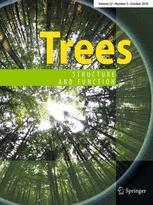Ver ítem
- xmlui.general.dspace_homeCentros e Institutos de InvestigaciónCIAP. Centro de Investigaciones AgropecuariasInstituto de Fisiología y Recursos Genéticos VegetalesArtículos científicosxmlui.ArtifactBrowser.ItemViewer.trail
- Inicio
- Centros e Institutos de Investigación
- CIAP. Centro de Investigaciones Agropecuarias
- Instituto de Fisiología y Recursos Genéticos Vegetales
- Artículos científicos
- Ver ítem
Drought stress tolerance of Prosopis chilensis and Prosopis flexuosa species and their hybrids
Resumen
Natural hybridization commonly produces individuals with intermediate morphological and genetic characteristics, but their response to environmental stress is still uncertain, with some studies showing that transgressive performance would be common. Prosopis chilensis and Prosopis flexuosa are the most important tree species from Arid Chaco, South-America. Both species occupy different ecological niches in terms of water availability. Genetic and
[ver mas...]
Natural hybridization commonly produces individuals with intermediate morphological and genetic characteristics, but their response to environmental stress is still uncertain, with some studies showing that transgressive performance would be common. Prosopis chilensis and Prosopis flexuosa are the most important tree species from Arid Chaco, South-America. Both species occupy different ecological niches in terms of water availability. Genetic and morphological studies have demonstrated the existence of interspecific hybrids in contact areas between these species. Hybrids are characterized by clear intermediate morphological characteristics, which have taxonomical value, and genetic structure compared to both parental species. We studied mechanisms implicated in drought stress tolerance in seedlings of P. chilensis, P. flexuosa and their interspecific hybrids trying to elucidate if hybrids have a morpho-physiological, growth and survival intermediate response to drought compared to differential parental responses or if they out-perform both parental species when subjected to drought. Our results suggest that hybridization does not result in individuals with intermediate mechanisms related to drought resistance, but with a unique trait combination leading to high growth when water availability is high (similar to the most vulnerable parental species) and high survival under drought stress (similar to the more resistant parental species). Certain uncoupling between symplastic and apoplastic resistence to drought was observed in hybrids, as well as decreased physiological-wood anatomical plasticity compared to parental species. The long-term consequences in terms of adaptive response to drought of this particular trait combination of hybrids remain still unknown.
[Cerrar]

Fuente
Trees 27 (1) : 285–296. (February 2013)
Fecha
2013-02
Editorial
Springer
ISSN
0931-1890
1432-2285 (Online)
1432-2285 (Online)
Formato
pdf
Tipo de documento
artículo
Palabras Claves
Derechos de acceso
Restringido
 Excepto donde se diga explicitamente, este item se publica bajo la siguiente descripción: Creative Commons Attribution-NonCommercial-ShareAlike 2.5 Unported (CC BY-NC-SA 2.5)
Excepto donde se diga explicitamente, este item se publica bajo la siguiente descripción: Creative Commons Attribution-NonCommercial-ShareAlike 2.5 Unported (CC BY-NC-SA 2.5)

